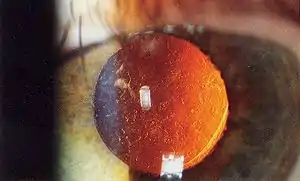Capsulotomy
Capsulotomy (BrE /kæpsjuː'lɒtəmi/, AmE /kæpsuː'lɑːtəmi/)[1] is a type of eye surgery in which an incision is made into the capsule of the crystalline lens of the eye. In modern cataract operations, the lens capsule is usually not removed. The most common forms of cataract surgery remove nearly all of the crystalline lens but do not remove the crystalline lens capsule (the outer “bag” layer of the crystalline lens). The crystalline lens capsule is retained and used to contain and position the intraocular lens implant (IOL).
| Capsulotomy | |
|---|---|
 Capsular opacification after cataract surgery | |
| ICD-9-CM | 13.19 |
| MeSH | D002387 |
Months or years after the cataract operation, the lens capsule can become opaque in about 30% of eyes.
Before the advent of laser surgery, a tiny knife called a cystotome was used to cut a hole in the center of the lens capsule, thus providing a clear path for light to reach the retina. This procedure thus reduces the opacity of the lens of the eye. This method has been replaced by YAG laser capsulotomy.[2]
References
- https://www.merriam-webster.com/medical/capsulotomy
- Cunningham, Emmett T.; Riordan-Eva, Paul (2011-05-17). Vaughan & Asbury's General Ophthalmology (18th ed.). McGraw-Hill Medical. ISBN 9780071634205.
Further reading
- Findl, O; Buehl, W; Bauer, P; Sycha, T; et al. (2010). "Interventions for preventing posterior capsule opacification". Cochrane Database of Systematic Reviews (2): CD003738. doi:10.1002/14651858.CD003738.pub3. PMID 20166069.